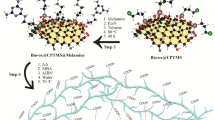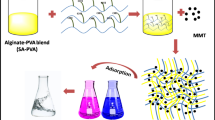Abstract
Three different environmentally friendly new composite hydrogels were synthesized and utilized as absorbents for removal of toluidine blue (TB), alizarin red S (AR), and gallocyanine (G) dyes from aqueous media. The homo and co-hydrogels were synthesized via redox polymerization technique from 2-acrylamido-2-methyl-1-propane sulfonic acid sodium salt (AMPS) and 3-acrylamidopropyl-trimethyl ammonium chloride (APTMACl). Polyporus squamosus (Huds.) Fr. [P. squamosus (Huds.) Fr.] fungus was utilized as the bio-part of the composite hydrogels. The effects of pH, contact time, and initial dyes concentrations on the absorption of composite hydrogels were investigated in sequence. It was concluded that Freundlich isotherm model was the best-fitted ones through the computation of the experimentally observed data for common isotherms models such as Freundlich and Langmuir. The maximum absorption of TB by p(AMPS)-P. squamosus (Huds.) Fr., of AR by p(APTMACl)-P. squamosus (Huds.) Fr., and of G by p(APTMACl)-P. squamosus (Huds.) Fr. composite hydrogels were obtained to be 40.9, 31.3, and 36.7 mg/g, respectively. In addition, kinetic studies were carried out for all composite hydrogels and absorbed dyes to obtain the absorption behaviors of studied dyes. They were generally fitted well to a pseudosecond-order kinetic model, while TB dye absorption on the p(AMPS)-P. squamosus (Huds.) Fr. composite hydrogel fitted a pseudofirst-order kinetic model. The obtained data were compared with the literature and it is indicated that absorption capacities of both anionic and cationic composite hydrogels were considerable for utilization.










Similar content being viewed by others
References
Akbari M, Hallajisani A, Keshtkar AR, Shahbeig H, Ghorbanian SA (2015) Equilibrium and kinetic study and modeling of Cu(II) and Co(II) synergistic biosorption from Cu(II)-Co(II) single and binary mixtures on brown algae C. indica. J Environ Chem Eng 3:140–149
Akgöl S, Kuşvuran E, Kara A, Senel S, Denizli A (2006) Porous dye affinity beads for nickel adsorption from aqueous solutions: a kinetic study. J Appl Polym Sci 100:5056–5065
Aksu Z, Karabayır G (2008) Comparison of biosorption properties of different kinds of fungi for the removal of Gryfalan Black RL metal-complex dye. Bioresour Technol 99:7730–7741
Al-Degs YS, El-Barghouthi MI, El-Sheikh AH, Walker GM (2008) Effect of solution pH, ionic strength, and temperature on adsorption behavior of reactive dyes on activated carbon. Dyes Pigment 77:16–23
Alpaslan D, Aktas N, Yilmaz S, Sahiner N, Guven O (2014) The preparation of p (acrylonitrile-co-acrylamide) hydrogels for uranyl ion recovery from aqueous environments. Hacet J Biol Chem 42:89–97
Alpat SK, Ozbayrak O, Alpat S, Akçay H (2008) The adsorption kinetics and removal of cationic dye, Toluidine Blue O, from aqueous solution with Turkish zeolite. J Hazard Mater 151:213–220
Barakat MA, Sahiner N (2008) Cationic hydrogels for toxic arsenate removal from aqueous environment. J Environ Manag 88:955–961
Bhattacharya AK, Naiya TK, Mandal SN, Das SK (2008) Absorption kinetics and equilibrium studies on removal of Cr(VI) from aqueous solutions using different low-cost adsorbent sing. Chem Eng J 137:529–541
Blanchard G, Maunaye M, Martin G (1984) Removal of heavy metals from waters by means of natural zeolites. Water Res 18:1501–1507
Caria G, Alzari V, Monticelli O, Nuvoli D, Kenny JM, Mariani A (2009) Poly(N,N-dimethylacrylamide) hydrogels obtained by frontal polymerization. J Polym Sci, Part A: Polym Chem 47:1422–1428
Dong K, Qiu F, Guo X, Xu J, Yang D, He K (2013) Adsorption behavior of azo dye eriochrome black T from aqueous solution by β-cyclodextrins/polyurethane foam material. Polym Plast Technol Eng 52:452–460
Ersen Dudu T, Sahiner M, Alpaslan D, Demirci S, Aktas N (2015) Removal of As (V), Cr(III) and Cr(VI) from aqueous environments by poly (acrylonitril-co-acrylamidopropyl-trimethyl ammonium chloride)-based hydrogels. J Environ Manag 161:243–251
Fan L, Zhang Y, Li X, Luo C, Lu F, Qiu H (2012) Removal of alizarin red from water environment using magnetic chitosan with Alizarin Red as imprinted molecules. Coll Surf B Biointerfaces 91:250–257
Freundlich HMF (1906) Uber die adsorption in losungen. Z Physikalische Chemi 57:385–470
Gautam RK, Mudhoo A, Chattopadhyaya MC (2013) Kinetic, equilibrium, thermodynamic studies and spectroscopic analysis of Alizarin Red S removal by mustard husk. J Environ Chem Eng 1:1283–1291
Gueu S, Yao B, Adouby K, Ado G (2007) Kinetics and thermodynamics study of lead adsorption on to activated carbons from coconut and seed hull of the palm tree. Int J Environ Sci Technol 4:11–17
Hameed BH, Mahmoud DK, Ahmad AL (2008) Equilibrium modeling and kinetic studies on the Absorption of basic dye by a low-cost adsorbent: coconut (Cocos nucifera) bunch waste. J Hazard Mater 158:65–72
Ho YS, McKay G (1999) Pseudo-second order model for sorption processes. Proc Biochem 34:451–465
Iyer A, Mody K, Jha B (2005) Biosorption of heavy metals by a marine bacterium. Marine Poll Bull 50:340–343
Jeon YS, Lei J, Kim JH (2008) Dye adsorption characteristics of alginate/polyaspartate hydrogels. J Ind Eng Chem 14:726–731
Karadağ E, Uzüm OB, Saraydin D (2002) Swelling equilibria and dye adsorption studies of chemically crosslinked superabsorbent acrylamide/maleic acid hydrogels. Eur Polym J 38:2133–2141
Kim YS, Kim DH, Yang JS, Baek K (2012) Adsorption characteristics of As(III) and As(V) on alum sludge from water purification facilities. Sep Sci Technol 47:2211–2217
Kumar PS, Ramalingam S, Senthamarai C, Niranjanaa M, Vijayalakshmi P, Sivanesan S (2010) Adsorption of dye from aqueous solution by cashew nut shell: studies on equilibrium isotherm, kinetics and thermodynamics of interactions. Desalination 261:52–60
Lagergren S (1898) Zur theorie der sogenannten adsorption geloester stoffe. Kungliga Svenska Vetenskapsa. Handlingar 24:1–39
Lakshmi UR, Srivastava VC, Mall ID, Lataye DH (2009) Rice husk ash as an effective adsorbent: evaluation of adsorptive characteristics for Indigo Carmine dye. J Environ Manag 90:710–720
Langmuir I (1918) The adsorption of gases on plane surfaces of glass, mica and platinum. J Am Chem Soc 40:1361
Li Y, Du Q, Liu T, Peng X, Wang J, Sun J, Wang Y, Wu S, Wang Z, Xia Y, Xia L (2013) Comparative study of methylene blue dye adsorption onto activated carbon, graphene oxide, and carbon nanotubes. Chem Eng Res Des 91:361–368
Mahanta D, Madras G, Radhakrishnan S, Patil S (2008) Adsorption of sulfonated dyes by polyaniline emeraldine salt and its kinetics. J Phys Chem B 112:10153–10157
Mane VS, Mall ID, Srivastava VC (2007) Kinetic and equilibrium isotherm studies for the adsorptive removal of Brilliant Green dye from aqueous solution by rice husk ash. J Environ Manag 84:390–400
Maurya NS, Mittal AK (2008) Selection of biosorbent: a case of dyes sorption. Nat Acad Sci Lett 31:221–227
Namasivayam C, Sureshkumar MV (2008) Removal of chromium(VI) from water and wastewater using surfactant modified coconut coir pith as a biosorbent. Bioresour Technol 99:2218–2225
Ozay O, Ekici S, Baran Y, Aktas N, Sahiner N (2009) Removal of toxic metal ions with magnetic hydrogels. Water Research 43: 4403-
Ozay O, Ekici S, Aktas N, Sahiner N (2011) P(4-vinyl pyridine) hydrogel use for the removal of UO2 2+ and Th4+ from aqueous environments. J Environ Manag 92:3121–3129
Pal A, Ghosh S, Paul AK (2006) Biosorption of cobalt by fungi from serpentine soil of Andaman. Bioresour Technol 97:1253–1258
Sahiner N (2009) A facile method for the preparation of poly(4-vinylpyridine) nanoparticles and their characterization. Turk J Chem 33:23–31
Sahiner N, Alpaslan D (2014) Metal-ion-containing ionic liquid hydrogels and their application to hydrogen production. J Appl Polym Sci. doi:10.1002/APP.40183
Sahiner N, Godbey WT, McPherson GL, John VT (2006) Microgel, nanogel and hydrogel–hydrogel semi-IPN composites for biomedical applications: synthesis and characterization. Coll Polym Sci 284:1121–1129
Sahiner N, Ozay H, Ozay O, Aktas N (2010) A soft hydrogel reactor for cobalt nanoparticle preparation and use in the reduction of nitrophenols. Appl Catal B Environ 101:137–143
Sahiner N, Ozay O, Aktas N (2011) Aromatic organic contaminant removal from an aqueous environment by p (4-VP)-based materials. Chemosphere 85:832–838
Sahiner M, Butun S, Alpaslan D, Bitlisli BO (2014) Preparation of collagen based composite materials with synthetic polymers for potential wound dressing applications. Hacet J Biol Chem 42:63–69
Sahiner N, Demirci S, Sahiner M, Yilmaz S, Al-Lohedan H (2015) The use of superporous p(3-acrylamidopropyl)trimethyl ammonium chloride cryogels for removal of toxic arsenate anions. J Environ Manag 152:66–74
Santhy K, Selvapathy P (2006) Removal of reactive dyes from wastewater by adsorption on coir pith activated carbon. J Bioresour Technol 97:1329–1336
Saraydın D, Karadag E, Güven O (2001) Use of Superswelling Acrylamide/Maleic Acid Hydrogels for Monovalent Cationic Dye Adsorption. J Appl Polym Sci 79:1809–1815
Selvam PP, Preethi S, Basakaralingam P, Thinakaran N, Sivasamy A, Sivanesan S (2008) Removal of rhodamine B from aqueous solution by adsorption onto sodium montmorillonite. J Hazard Mater 155:39–44
Sharma I, Goyal D (2009) Kinetic modeling: chromium(III) removal from aqueous solution by microbial waste biomass. J Sci Ind Res 68:640–646
Soylak M, Tuzen M, Mendil D, Turkekul I (2006) Biosorption of heavy metals on Aspergillus fumigatus immobilized Diaion HP-2MG resin for their atomic absorption spectrometric determinations. Talanta 70:1129–1135
Tasdelen B, Izlen Cifci D, Meric S (2016) Preparation of N-isopropylacrylamide/itaconic acid/Pumice highly swollen composite hydrogels to explore their removal capacity of methylene blue Physicochemical and Engineering Aspects. Coll Surf A. doi:10.1016/j.colsurfa.2016.11.003
Tian G, Geng J, Jin Y, Wang C, Li S, Chen Z, Wang H, Zhao Y, Li S (2011) Sorption of uranium(VI) using oxime-grafted ordered mesoporous carbon CMK-5. J Hazard Mater 190:442–450
Tunc O, Tanacı H, Aksu Z (2009) Potential use of cotton plant wastes for the removal of Remazol Black B reactive dye. J Hazard Mater 163:187–198
Vijayaraghavan K, Jegan J, Palanivelu K, Velan M (2005) Biosorption of cobalt(II) and nickel(II) by seaweeds: batch and column studies. Sep Purif Technol 44:53–59
Wang W, Wang A (2009) Synthesis, swelling behaviors, and slow-release characteristics of a guar gum-g-poly(sodium acrylate)/sodium humate superabsorbent. J Appl Polym Sci 112:2102–2111
Wang HL, Li P, Liu GS, Li X, Yao JM (2010) Rapid biodecolourization of eriochrome black T wastewater by bioaugmented aerobic granules cultivated through a specific method. Enzyme Microb Technol 47:37–43
Yagub MT, Sen TK, Afroze S, Ang HM (2014) Dye and its removal from aqueous solution by adsorption: a review. Adv Coll Interface Sci 209:172–184
Yu C, Wang F, Zhang C, Fu S, Lucia LA (2016) The synthesis and absorption dynamics of a lignin-based hydrogel for remediation of cationic dye-contaminated effluent. React Funct Polym 106:137–142
Zolgharnein J, Asanjrani N, Bagtash M, Azimi G (2014a) Multi-response optimization using Taguchi design and principle component analysis for removing binary mixture of alizarin red and alizarin yellow from aqueous solution by nano γ-alumina. Spectrochim Acta Part A Mol Biomol Spectrosc 126:291–300
Zolgharnein J, Bagtash M, Asanjarani N (2014b) Hybrid central composite design approach for simultaneous optimization of removal of Alizarin Red S and Indigo Carmine dyes using cetyltrimethylammonium bromide-modified TiO2 nano-particles. J Environ Chem Eng 2:988–1000
Author information
Authors and Affiliations
Corresponding author
Rights and permissions
About this article
Cite this article
Dudu, T.E., Alpaslan, D., Uzun, Y. et al. Utilization of Hydrogel–Fungus Composites as Absorbents for Removal of Textile Dyes from Aqueous Media. Int J Environ Res 11, 557–568 (2017). https://doi.org/10.1007/s41742-017-0050-2
Received:
Revised:
Accepted:
Published:
Issue Date:
DOI: https://doi.org/10.1007/s41742-017-0050-2




